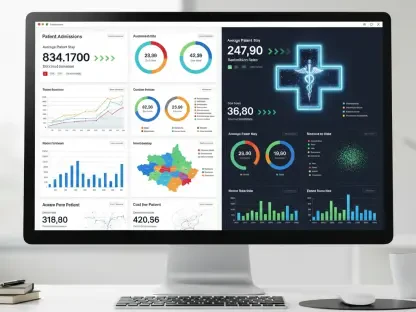Overview of the Experience Management and Healthcare Technology Landscape
Imagine a world where every interaction, whether with a customer, employee, or patient, is not just measured but transformed into meaningful improvement—such is the promise of the experience management industry, which today stands at a pivotal intersection with healthcare technology. This sector focuses on harnessing data to enhance relationships and outcomes across diverse touchpoints, a mission that has gained momentum as organizations recognize the value of understanding human experiences. With digital transformation accelerating, experience management has become a cornerstone for industries aiming to build trust and loyalty through personalized engagement.
The significance of this field extends deeply into healthcare, where patient and employee experiences directly impact care quality and operational efficiency. Major players like Qualtrics, a pioneer in experience management software, and Press Ganey Forsta, a leader in healthcare-specific human experience solutions, have shaped the market by offering tools to analyze and act on feedback. Their innovations cater to a growing demand for platforms that bridge the gap between raw data and actionable insights, especially in an environment where every decision can affect lives.
Driving this evolution are advancements in artificial intelligence and data analytics, which enable real-time processing and predictive capabilities, revolutionizing how organizations respond to needs. In healthcare technology, the scope broadens to include improving patient outcomes while navigating stringent regulatory demands. As these two domains converge, the combined focus on technology and compliance creates a dynamic landscape ripe for innovation and strategic growth, setting the stage for transformative deals that redefine industry standards.
Strategic Implications of the $6.75 Billion Acquisition
Key Drivers and Synergies of the Deal
The acquisition of Press Ganey Forsta by Qualtrics for $6.75 billion represents a calculated move to penetrate deeper into the healthcare sector, an area where experience management holds immense potential for impact. Qualtrics, known for its robust AI-driven platforms, aims to leverage this deal to expand its reach into a market where patient satisfaction and clinical outcomes are intertwined. This strategic expansion aligns with a broader vision to dominate specialized verticals beyond traditional customer and employee feedback.
Complementing this ambition is Press Ganey Forsta’s established expertise in healthcare, serving over 41,000 clients globally and holding a strong foothold in 85% of U.S. health plans. The merger promises synergies by integrating Qualtrics’ advanced analytical tools with Press Ganey Forsta’s deep understanding of industry-specific challenges, creating a powerhouse capable of delivering tailored solutions. This combination is expected to enhance capabilities in benchmarking and regulatory compliance, areas critical to healthcare providers.
Moreover, the deal addresses significant barriers to AI adoption, such as trust and relevance, by combining technological innovation with sector-specific knowledge. The unified platform aims to offer comprehensive experience management solutions across industries, positioning the merged entity as a leader in delivering actionable insights. This synergy could redefine how organizations approach human interactions, making data not just a metric but a catalyst for meaningful change.
Financial and Operational Details
Financially, the $6.75 billion transaction is structured as a mix of cash and equity, reflecting a balanced approach to funding such a substantial acquisition. Qualtrics, having generated over $500 million in free cash flow in the past 12 months, demonstrates the fiscal strength to support this deal. This financial health underscores confidence in sustaining growth while integrating a major player into its portfolio.
Operationally, both companies will maintain independence until the deal closes, pending necessary regulatory approvals and customary conditions expected to finalize in the coming months. This interim arrangement ensures continuity for clients and minimizes disruption during the transition. The careful planning of this phase highlights a commitment to preserving value for stakeholders on both sides of the agreement.
Backing this ambitious move are prominent investors like Silver Lake Technology Partners and Canada Pension Plan Investment Board, whose support provides a strong foundation for execution. Their involvement signals market confidence in the strategic direction of the acquisition, reinforcing the potential for long-term success. This financial and strategic backing is poised to facilitate a smooth integration once approvals are secured.
Challenges and Barriers in the Integration Process
Merging two entities as distinct as Qualtrics and Press Ganey Forsta presents notable challenges, particularly in aligning corporate cultures and operational frameworks. Differences in organizational priorities, with Qualtrics focusing on broad technological innovation and Press Ganey Forsta on niche healthcare solutions, could create friction during the unification process. Addressing these disparities will require deliberate efforts to foster collaboration and shared goals.
Regulatory hurdles also loom large, especially given the healthcare sector’s stringent compliance requirements. Ensuring adherence to clinical protocols and data privacy standards will be paramount, as any lapse could undermine client trust and operational legitimacy. Navigating this complex landscape demands meticulous planning to meet legal expectations without compromising efficiency or innovation.
Additionally, scaling AI solutions across diverse industries while maintaining trust and relevance poses a significant obstacle. Balancing the need for broad applicability with tailored, sector-specific outcomes will test the combined entity’s adaptability. To mitigate these risks, a phased integration approach, coupled with transparent communication to stakeholders, could help align expectations and build confidence in the merged organization’s capabilities.
Regulatory and Compliance Considerations in Healthcare Technology
The healthcare technology sector operates within a tightly regulated environment, where adherence to clinical protocols and data privacy laws is non-negotiable. Standards such as HIPAA in the United States govern how patient information is handled, imposing strict guidelines that companies must follow to avoid penalties. For Press Ganey Forsta, compliance has long been a core component of its operations, shaping its approach to client services.
Post-acquisition, Qualtrics must adapt to these rigorous demands, integrating healthcare-specific regulations into its broader experience management framework. This adaptation will involve aligning its AI and data analytics tools with protocols that prioritize patient safety and confidentiality. Failure to do so could jeopardize the credibility of the combined entity in a sector where trust is paramount.
Security measures to protect sensitive patient and client data will also play a critical role in maintaining compliance. Robust encryption, access controls, and regular audits are essential to safeguard information against breaches. As the merged company scales its offerings, embedding these protective mechanisms into every facet of its technology will be vital to meeting regulatory expectations and preserving stakeholder confidence.
Future Outlook for Experience Management and Healthcare Innovation
Looking ahead, the acquisition is set to reshape the experience management industry by establishing a new benchmark for integrated, AI-driven solutions. The combined strengths of Qualtrics and Press Ganey Forsta are likely to accelerate the adoption of real-time analytics, enabling organizations to respond swiftly to feedback and trends. This capability could redefine service delivery, particularly in healthcare, where timely interventions can save lives.
Emerging trends, such as personalized patient experiences powered by data insights, point to a future where customization becomes standard. Additionally, market consolidation is expected to intensify as larger players acquire specialized firms to broaden their expertise, mirroring the current deal. Such shifts may introduce disruptors that challenge established norms, pushing innovation to new heights across sectors.
Growth opportunities abound, especially in healthcare and adjacent industries, where tailored, data-driven solutions can address unique pain points. Global economic conditions and rapid technological advancements will further influence strategic priorities, urging the merged entity to remain agile. By capitalizing on these dynamics, the company can position itself as a leader in transforming how human experiences are understood and enhanced.
Final Thoughts and Strategic Path Forward
Reflecting on this landmark deal, the integration of Qualtrics and Press Ganey Forsta marks a significant chapter in the evolution of experience management, particularly within healthcare. The strategic alignment of technological innovation with sector-specific expertise promises to address critical gaps in AI adoption and service delivery. This acquisition stands as a testament to the power of combining complementary strengths to tackle complex industry challenges.
Moving forward, stakeholders are encouraged to prioritize regulatory compliance as a cornerstone of operational success, ensuring that every innovation adheres to legal and ethical standards. Building trust in AI applications through transparency and proven outcomes becomes a key focus, as does the need to tailor solutions to diverse industry needs. These steps are seen as essential to sustaining momentum and credibility in a competitive landscape.
As a final consideration, investing in continuous dialogue with clients and regulators offers a pathway to anticipate and adapt to emerging demands. By fostering such collaboration, the combined entity can not only navigate integration challenges but also set a precedent for how technology and human experience intersect. This proactive stance is poised to drive lasting impact, cementing a leadership role in shaping the future of experience management.









